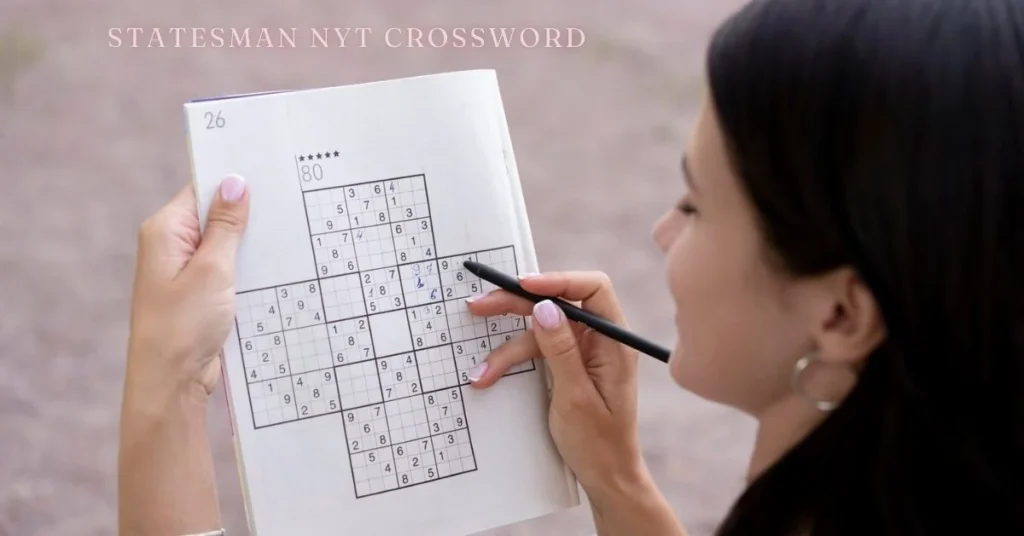Introduction to NYT Crossword
If you’ve ever stared at a blank NYT Crossword puzzle, feeling both intrigued and overwhelmed, you’re not alone. The Statesman NYT Crossword has gained a reputation for being challenging yet rewarding. It’s the perfect blend of wit, wordplay, and trivia that can turn an ordinary day into an exhilarating mental workout.
Crossword puzzles have been captivating minds for generations. They offer more than just entertainment; they sharpen your cognitive skills and expand your vocabulary. Whether you’re a seasoned solver or just dipping your toes in the world of crosswords, there’s always something new to learn.
Ready to unlock the secrets behind mastering the Statesman NYT Crossword? Let’s dive in!
The Benefits of Solving Crosswords
Solving crosswords offers a refreshing mental workout. Engaging with these puzzles can enhance your vocabulary and improve your language skills. Each clue challenges you to think creatively, pulling from various knowledge areas.
Moreover, tackling crosswords boosts cognitive functions. It sharpens critical thinking and encourages pattern recognition. This form of brain exercise is akin to lifting weights for the mind.
Crossword enthusiasts often find stress relief in their daily routines. The meditative focus required can provide a break from life’s chaos. You immerse yourself in words, allowing worries to fade temporarily.
Socially, crosswords create connections too. They encourage conversations among friends or family members who share the same passion for puzzle-solving. Collaborating on tricky clues fosters teamwork and camaraderie.
Regular crossword practice may slow cognitive decline as we age, making it not only enjoyable but also beneficial for long-term brain health.
Tips for Beginners
Starting out with the NYT Crossword can feel overwhelming. But don’t worry; it’s all about practice and patience.
Begin by focusing on the easiest clues. Look for fill-in-the-blank questions or simple definitions. They often provide a solid foundation to build upon.
Don’t hesitate to use pencil instead of ink. This allows you to erase mistakes without frustration, making it easier to adjust your answers as needed.
Familiarize yourself with common crossword lingo. Words like “era” or “one” frequently pop up in various puzzles, so recognizing them can save time and effort.
Make it a habit to solve consistently. Dedicate time each day or week solely for crosswords. The more you engage, the better you’ll become at spotting patterns and filling those grids efficiently.
Advanced Strategies for Experienced Solvers
Experienced crossword solvers know that intuition is key. Trust your instincts when filling in the blanks. If a word feels right, it often is.
Familiarity with common crosswordese can also elevate your game. Phrases like “ore” for mine or “Eve” for the beginning of something are staples you should recognize quickly.
Consider working backward, too. Start with filled letters and deduce possible words from there. This technique can unlock tougher clues more easily.
Using themed knowledge effectively pays off as well. The New York Times often centers its puzzles around specific themes or current events, so staying informed helps you make connections faster.
Don’t shy away from collaboration. Discussing tricky clues with fellow enthusiasts can reveal new strategies and insights that sharpen your skills even further.
Common Tricks and Traps in NYT Crossword
The NYT Crossword is a delightful challenge, but it can be tricky. One common pitfall is misreading clues. Sometimes they are more cryptic than literal. A clue might ask for a “capital” where you need to think beyond geography.
Another trap involves obscure references. Popular culture and historical figures often pop up unexpectedly. If you’re not familiar with them, those squares can remain frustratingly blank.
Watch out for wordplay! Puns and homophones frequently appear in the clues, turning straightforward answers into riddles.
Additionally, many experienced solvers use the same set of words repeatedly—think “Eli,” “Oleo,” or “Aida.” These favorites crop up regularly and may lead you astray if you’re unprepared.
Don’t overlook abbreviations; they’re often sneaky suspects hiding in plain sight within longer phrases.
Resources for Improving Your Skills
To sharpen your crossword skills, immerse yourself in diverse resources. Start with books like “The New York Times Crossword Puzzle Dictionary.” It offers insights into common clues and answers.
Online platforms provide interactive experiences. Websites such as Crossword Nexus allow you to solve puzzles at varying difficulty levels, helping you track progress over time.
Consider joining forums or social media groups dedicated to crosswords. Engaging with fellow enthusiasts can expose you to new solving techniques and tips that might not be widely known.
Apps are another great tool for practice on the go. The NYT Crossword app offers daily challenges that keep your skills sharp while adding a layer of convenience.
Watch videos from seasoned solvers who share their strategies on platforms like YouTube. Observing their thought processes can inspire fresh approaches to tricky clues and enhance overall understanding of the game’s nuances.
Conclusion
Solving the Statesman NYT Crossword can be a rewarding journey. Whether you are just starting or have been filling in squares for years, there’s always something new to learn. The thrill of cracking clues and discovering hidden meanings is what makes crosswords so captivating.
By utilizing beginner tips and advanced strategies, you can enhance your problem-solving skills significantly. Remember to stay curious about language and history—these elements often intertwine within the puzzles.
Pay attention to common pitfalls; they can help sharpen your ability to see beyond surface-level clues. Engaging with resources designed for crossword enthusiasts will also keep your skills fresh and improve your overall performance.
With practice, patience, and a bit of creativity, you’ll find that tackling the Statesman NYT Crossword becomes not only easier but an enjoyable part of your daily routine. Embrace the challenge—it might just surprise you how much fun solving these puzzles can be!
FAQs
What is “Statesman NYT Crossword”?
“Statesman NYT Crossword” refers to clues in the New York Times crossword puzzles that involve political figures or world leaders, often requiring knowledge of historical or diplomatic figures.
How can I improve my skills for solving the Statesman NYT Crossword?
To improve your skills, start by practicing regularly, familiarize yourself with common crossword clues, and utilize beginner tips like focusing on simple clues and learning crosswordese.
Why are statesman clues so common in the NYT Crossword?
Statesman clues are popular because they combine history, politics, and culture, making them an interesting challenge for solvers while testing a broad range of general knowledge.
What are some common tricks for tackling difficult Statesman NYT Crossword clues?
Look out for wordplay, abbreviations, and historical references. Trust your instincts, work backward with filled letters, and stay informed about current events and historical figures.
Where can I find resources to improve my crossword-solving abilities?
You can find resources such as “The New York Times Crossword Puzzle Dictionary,” online platforms like Crossword Nexus, apps like the NYT Crossword app, and forums where enthusiasts share tips and strategies.






